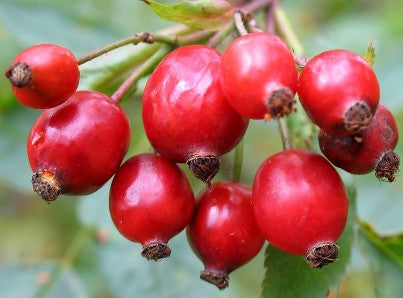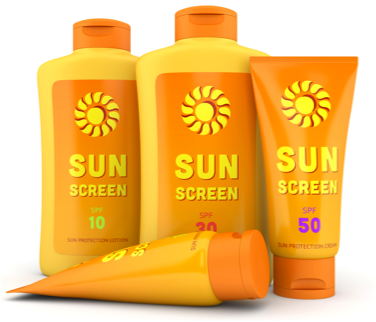-
ROSEHIP SEED RESEARCH:

Composition and content of biologically active substances in rose hips
Dubtsova GN, Negmatulloeva RN, Bessonov VV, Baĭkov VG, Sheviakova LV, Makhova NN, Perederiaev OI, Bogachuk MN, Baĭgarin EK.
Abstract
The paper studies the chemical composition of the powders obtained from the pulp with the skins and seeds of fruits of wild rose hips. Research results have shown that the main fraction of the powder is dietary fiber, powder of seeds of insoluble fiber in 1,6 and 2,3 higher than in the powder of the fruit with a thin skin and pulp, respectively. The greatest amount of carbohydrates and protein found in powders and pulp of the fruit with a thin skin, and lipids predominate in the powder from the seeds. Found that the lipid powder rosehip richest in oleic, linoleic and linolenic acids, the share of oleic acid has 6,4-19,2%, linoleic and linolenic 19,7-45,8 and 23,3-33,9% of the amount of fatty acids. Lipids powders of hips and seeds of rose have higher levels of essential linoleic acid and powder from the pulp with the skins - linolenic acid. In the study established the presence of sterols 7 fractions, the predominant of which is the beta-sitosterol. In the powder from the pulp with the skins found the greatest amount of ascorbic acid, carotenoids, and the powder of seeds - vitamin E. Carotenoids in powders are beta-carotene and lycopene.

The high content of ascorbic acid, vitamin E and carotenoids in powder from wild rose hips makes them a good source of antioxidants. Therefore, we studied the possibility of using vegetable powders obtained from hips of wild rose, to enrich biologically active substances such as vitamins C, E and carotenoids, food supply, particularly of health care use. Rosehip powder from the pulp with the skins had the highest antioxidant activity, antioxidant activity of hips powders was 74% of the activity of powder from the pulp with the skins, and the lowest antioxidant activity was observed in the powder from the wild rose seeds. That's way, based on the analysis of the chemical composition of rose hip powder found high levels they ascorbic acid, carotenoids, flavonoids, found their high antioxidant activity. It allows recommending powders produced from the hips, as a source of physiologically functional ingredients for the production of fortified food products, especially medical and prophylactic purposes. The use of such additives will fill the gap in the body of P-active substances, vitamins C and E, beta-carotene, pectin substances.
-
SEABUCKTHORN RESEARCH:
Fatty acid composition of developing sea buckthorn (Hippophae rhamnoides L.) berry and the transcriptome of the mature seed.
Fatima T1, Snyder CL, Schroeder WR, Cram D, Datla R, Wishart D, Weselake RJ, Krishna P.
PLoS One. 2012;7(4):e34099. doi: 10.1371/journal.pone.0034099. Epub 2012 Apr 27.
Abstract
BACKGROUND:
Sea buckthorn (Hippophae rhamnoides L.) is a hardy, fruit-producing plant known historically for its medicinal and nutraceutical properties. The most recognized product of sea buckthorn is its fruit oil, composed of seed oil that is rich in essential fatty acids, linoleic (18:2 ω-6) and α-linolenic (18:3 ω-3) acids, and pulp oil that contains high levels of monounsaturated palmitoleic acid (16:1 ω-7). Sea buckthorn is fast gaining popularity as a source of functional food and nutraceuticals, but currently has few genomic resources; therefore, we explored the fatty acid composition of Canadian-grown cultivars (ssp. mongolica) and the sea buckthorn seed transcriptome using the 454 GS FLX sequencing technology.
RESULTS:
GC-MS profiling of fatty acids in seeds and pulp of berries indicated that the seed oil contained linoleic and α-linolenic acids at 33-36% and 30-36%, respectively, while the pulp oil contained palmitoleic acid at 32-42%. 454 sequencing of sea buckthorn cDNA collections from mature seeds yielded 500,392 sequence reads, which identified 89,141 putative unigenes represented by 37,482 contigs and 51,659 singletons. Functional annotation by Gene Ontology and computational prediction of metabolic pathways indicated that primary metabolism (protein>nucleic acid>carbohydrate>lipid) and fatty acid and lipid biosynthesis pathways were highly represented categories. Sea buckthorn sequences related to fattyacid biosynthesis genes in Arabidopsis were identified, and a subset of these was examined for transcript expression at four developing stages of the berry.
CONCLUSION:
This study provides the first comprehensive genomic resources represented by expressed sequences for sea buckthorn, and demonstrates that the seed oil of Canadian-grown sea buckthorn cultivars contains high levels of linoleic acid and α-linolenic acid in a close to 1:1 ratio, which is beneficial for human health. These data provide the foundation for further studies on sea buckthorn oil, the enzymes involved in its biosynthesis, and the genes involved in the general hardiness of sea buckthorn against environmental conditions.
-
Sunscreens
Adv Exp Med Biol. 2014;810:429-63.
Abstract
Sunscreens have become since more than 40 years the most popular means of protection against UV radiation (UVR) in Western countries. Organic and inorganic filters with different absorption spectrum exist. They filter or scatter UVR. Protection from UVB is quantified as a minimal erythema dose-based sun protection factor. UVA protection testing is less standardized: Persistent pigment darkening and critical wavelength are currently used methods. Marketing and labeling of sunscreens underlay national regulation, which explains major differences between the European and the US sunscreen market. Sunscreens are most performing in sunburn prevention. Broad-spectrum UVB and UVA protection and regular application in sufficient amounts are essential for prevention of skin cancers, UV-induced immunosuppression, and skin aging. A significant benefit from regular sunscreen use has not yet been demonstrated for primary prevention of basal cell carcinoma and melanoma. Concerning the prevention of actinic keratoses, squamous cell carcinomas, and skin aging, the effect of sunscreens is significant, but it remains incomplete.

Some organic UV filters (PABA derivatives, cinnamates, benzophenones, and octocrylene) have been described to cause photoallergy. Percutaneous absorption and endocrine disrupting activity of small-sized organic and nano-sized inorganic UV filters have been reported. On lesional skin and in pediatric settings, these products should be used with caution. Cutaneous vitamin D synthesis depending on skin-carcinogenic UVB radiation, the potential risk of vitamin D deficiency by sunscreen use has become a major subject of public health debate. Sunscreens indeed impair vitamin D synthesis if they are used in the recommended amount of 2 mg/cm2, but not in lesser thickness below 1.5 mg/cm2 that corresponds better to what users apply in real life conditions. Large molecular last generation UVB-UVA broad-spectrum sunscreens have a better benefit-risk ratio than former organic filters: They offer better protection in the UVA band, they are non toxic and non allergenic. A better outcome of sunscreen efficacy especially in primary skin cancer prevention may be achieved with these molecules.
Sun protection factors: worldwide confusion.
Br J Dermatol. 2009 Nov;161 Suppl 3:13-24. doi: 10.1111/j.1365-2133.2009.09506.x.
The Sun Protection Factor (SPF) is a very popular instrument in the marketing of sunscreens. Unfortunately it is often not understood how sunscreens work and where the limitations of the SPF are. A lot of aspects of the SPF are confusing, e.g. the race for higher and higher numbers, the effect on SPF when less sunscreen is applied and if sunscreen should be used at all because they may block the Vitamin D synthesis. All this has a negative impact on compliance by the consumer or patient who is the most important influence factor in sun protection. This paper explains how sunscreens work, how the SPF is determined and where the limitations of the current methods exist. The dynamic view of 'UV radiation applied' and the 'UV dose transmitted' through the sunscreen onto the skin as well as onto a substrate in vitro help in the understanding and are also promising approaches in the in vitro assessment. A variation of the in vitro assessment of a sunscreen is the in silico calculation based on the absorption spectrum of the UV filters and an assumption about the irregular sunscreen film on the skin. The sunscreen simulator program can be used to determine how the SPF is affected by applying smaller amounts of sunscreen. Besides the SPF, UVA protection is also discussed. The degree of UVA protection determines the quality of the overall UV protection, whereas the SPF is an indication of the quantity of protection. Furthermore other protection factors such as IPF, iSPF, RSF and p53, and the inhibition of the Vitamin D3 synthesis by sunscreens are also discussed. In conclusion it is shown that the accuracy and robustness of the SPF and other Protection Factors will improve significantly with the availability of true broad-spectrum sunscreens rather than conventional UVB-biased sunscreens, because uniform protection profiles lead to protection independent of the action spectrum of the endpoint and the UV-radiation source.
-
ZEATIN CYTOKININS RESEARCH:
Principal component analysis of hormone profiling data suggests an important role for cytokinins in regulating leaf growth and senescence of salinized tomato.
Albacete A1, Ghanem ME, Dodd IC, Pérez-Alfocea F.
Plant Signal Behav. 2010 Jan;5(1):45-8.

Abstract
High throughput analytical methods allow phytohormonal profiling, but the magnitude of the data generated makes it difficult to draw firm conclusions about the physiological roles of different compounds. Principal component analysis (PCA) was used as a mathematical tool to evaluate relationships between physiological and hormonal variables in two experiments with salinised tomato. When tomato plants (cv Boludo F1) were grafted onto a recombinant inbred line (RIL) population derived from a Solanum lycopersicum x S. cheesmaniae cross and grown under moderate salinity (75 mM NaCl) for 100 days under greenhouse conditions, PCA revealed an important role for leaf xylem cytokinins (CKs) in controlling leaf growth and photosystem II efficiency (Fv/Fm) and thus crop productivity under salinity. PCA analysis from a similar experiment, with ungrafted tomato grown under highly saline (100 mM NaCl) conditions, that evaluated the temporal sequence of leaf growth (as relative growth rate, LRGR) and senescence and hormone concentrations, revealed a similar influence of CKs on both processes, since Fv/Fm and LRGR were strongly loaded along the two principal components and placed in the same cluster as leaf trans-zeatin and/or related to other CK-related parameters. The conservative behaviour of the eigen vectors for Fv/Fm and the analyzed phytohormones in different compartments (xylem, leaf and root) between different experiments suggests an important role for CKs in regulating leaf senescence, while CKs and other hormones seem to regulate leaf growth under salinity.
Gerontomodulatory and youth-preserving effects of zeatin on human skin fibroblasts undergoing aging in vitro.
Rejuvenation Res. 2005 Spring;8(1):46-57.
Abstract
Our studies have shown that zeatin, (6-[4-hydroxy-3-methyl-but-2-enylamino]adenine), a cytokinin plant growth factor, has gerontomodulatory, youth preserving and anti-aging effects on serially passaged human adult skin fibroblasts undergoing aging in vitro. There were no immediate negative or toxic effects in terms of cell attachment, cell proliferation, cell survival, cytoskeletal organization, and cellular growth by treatment with zeatinconcentrations between 1 and 200 microM. During long-term treatment, cells could be maintained throughout their replicative lifespan in the presence of 40, 80, and 200 microM zeatin, but the optimal concentration of zeatin's anti-aging and youth preserving effects was found to be 80 microM. Life-long serial passaging of human skin fibroblasts in the presence of zeatin resulted in the prevention of cell enlargement, reduction of intracellular debris, prevention of actin polymerization, and enhancement of cellular ability to decompose hydrogen peroxide and to cope with ethanol and oxidative stresses. Most importantly, anti-aging and beneficial effects of zeatin were observed without any induction of additional cell proliferation or an increase in the maximum proliferative capacity, thus ruling out any potentially harmful and carcinogenic effects.
-
Jojoba Oil Research:
Evaluation of the mechanism of gelation of an oleogel based on a triterpene extract from the outer bark of birch.
harmazie. 2013 Jul;68(7):572-7.http://www.ncbi.nlm.nih.gov/pubmed/23923639

Abstract
Oleogels are known for their high physical, chemical, and mechanical stability and good in vivo efficacy, which make them appropriate vehicles for dermal drug delivery and skin care for very dry skin. Modern formulation research focusses on well tolerated and sustainable formulation concepts. This paper deals with an innovative oleogel, which is based on a triterpene dry extract from the outer bark of birch (TE). In this formulation TE does not only act as an excipient but provides interesting pharmacological properties at the same time. The oleogel was formulated using solely Simmondsia Chinensis seed oil (jojoba oil) and TE. Fluorescence microscopy and confocal Raman microscopy showed that suspended TE particles arrange in a three-dimensional gel network. Infrared spectroscopy revealed that the formation of hydrogen bonds between TE particles is responsible for the self-assembly of TE in oil. Moreover, the influence of TE concentration and morphology of the TE particles on the viscoelasticity of the resulting oleogels was analyzed. Gel strength increased with TE concentration and was critical to the specific surface area of the TE particles.
Birch bark research and development.
Nat Prod Rep. 2006 Dec;23(6):919-42. Epub 2006 Sep 18.
http://www.ncbi.nlm.nih.gov/pubmed/17119640
Abstract
This review will detail progress made in the previous decade on the chemistry and bioactivity of birch bark extractive products. Current and future applications of birch bark natural products in pharmaceuticals, cosmetics, and dietary supplements for the prevention and treatment of cancer, HIV,and other human pathogens are reviewed. Current developments in the technology of birch bark processing are discussed. New approaches for the synthesis of potentially valuable birch bark triterpenoid derivatives are also reviewed.
Advances in the study of structural modifications and biological activities of betulinic acids
Lan P1, Zhang DM, Chen WM, Ye WC.
Yao Xue Xue Bao. 2010 Nov;45(11):1339-45.
http://www.ncbi.nlm.nih.gov/pubmed/21361032
Abstract
Betulinic acids are lupine-type pentacyclic triterpenoid saponins commonly found in some plants of Betulaceae family, especially in the bark of betula alba (birch). The potent anti-HIV and anti-tumor activities of betulinic acids have been greatly concerned. The natural betulinic acids include betulinic acid, 23-hydroxy betulinic acid, betulin and so on. Some investigations on the structural modifications of betulinic acids were carried out, and many derivatives with excellent biological activity have been obtained nowadays. In this paper, the research advances of the structural modification of betulinic acids, as well as their anti-HIV and anti-tumor activities are reviewed.
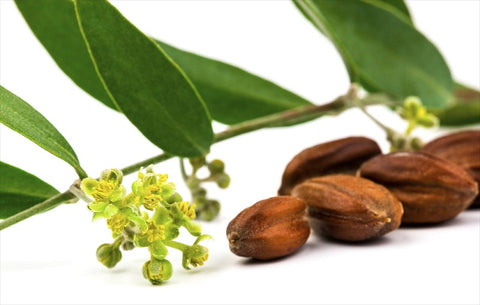
Chemistry, biological activity, and chemotherapeutic potential of betulinic acid for the prevention and treatment of cancer and HIV infection.
Med Res Rev. 2004 Jan;24(1):90-114.
http://www.ncbi.nlm.nih.gov/pubmed/14595673
Abstract
3beta-Hydroxy-lup-20(29)-en-28-oic acid (betulinic acid) is a pentacyclic lupane-type triterpene that is widely distributed throughout the plant kingdom. A variety of biological activities have been ascribed to betulinic acid including anti-inflammatory and in vitro antimalarial effects. However, betulinic acid is most highly regarded for its anti-HIV-1 activity and specific cytotoxicity against a variety of tumor cell lines. Interest in developing even more potent anti-HIV agents based on betulinic acid has led to the discovery of a host of highly active derivatives exhibiting greater potencies and better therapeutic indices than some current clinical anti-HIV agents. While its mechanism of action has not been fully determined, it has been shown that some betulinic acid analogs disrupt viral fusion to the cell in a post-binding step through interaction with the viral glycoprotein gp41 whereas others disrupt assembly and budding of the HIV-1 virus. With regard to its anticancer properties, betulinic acid was previously reported to exhibit selective cytotoxicity against several melanoma-derived cell lines. However, more recent work has
demonstrated that betulinic acid is cytotoxic against other non-melanoma (neuroectodermal and malignant brain tumor) human tumor varieties. Betulinic acid appears to function by means of inducing apoptosis in cells irrespective of their p53 status. Because of its selective cytotoxicity against tumor cells and favorable therapeutic index, even at doses up to 500 mg/kg body weight, betulinic acid is a very promising new chemotherapeutic agent for the treatment of HIV infection and cancer.
Pentacyclic triterpenes of the lupane, oleanane and ursane group as tools in cancer therapy.
Planta Med. 2009 Dec;75(15):1549-60. doi: 10.1055/s-0029-1186102.
Abstract
Today cancer treatment is not only a question of eliminating cancer cells by induction of cell death. New therapeutic strategies also include targeting the tumour microenvironment, avoiding angiogenesis, modulating the immune response or the chronic inflammation that is often associated with cancer. Furthermore, the induction of redifferentiation of dedifferentiated cancer cells is an interesting aspect in developing new therapy strategies. Plants provide a broad spectrum of potential drug substances for cancer therapy with multifaceted effects and targets. Pentacyclic triterpenes are one group of promising secondary plant metabolites. This review summarizes the potential of triterpenes belonging to the lupane, oleanane or ursane group, to treat cancer by different modes of action. Since Pisha et al. reported in 1995 that betulinic acid is a highly promising anticancer drug after inducing apoptosis in melanoma cell lines in vitro and in vivo, experimental work focused on the apoptosis inducing mechanisms of betulinic acid and other triterpenes. The antitumor effects were subsequently confirmed in a series of cancer cell lines from other origins, for example breast, colon, lung and neuroblastoma. In addition, in the last decade many studies have shown further effects that justify the expectation that triterpenes are useful to treat cancer by several modes of action. Thus, triterpene acids are known mainly for their antiangiogenic effects as well as their differentiation inducing effects. In particular, lupane-type triterpenes, such as betulin, betulinic acid and lupeol, display anti-inflammatory activities which often accompany immune modulation.
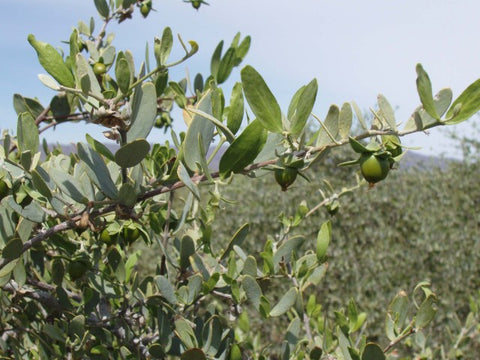
Triterpene acids as well as triterpene monoalcohols and diols also show an antioxidative potential. The pharmacological potential of triterpenes of the lupane, oleanane or ursane type for cancer treatment seems high; although up to now no clinical trial has been published using these triterpenes in cancer therapy. They provide a multitarget potential for coping with new cancer strategies. Whether this is an effective approach for cancer treatment has to be proven.
Because various triterpenes are an increasingly promising group of plant metabolites, the utilisation of different plants as their sources is of interest. Parts of plants, for example birch bark, rosemary leaves, apple peel and mistletoe shoots are rich in triterpenes and provide different triterpene compositions.
Anti-inflammatory Effects
Due to its anti-inflammatory effect, jojoba oil is used in folk medicine to assist in wound healing, treat skin infections and other skin afflictions, and even slow the aging of skin. A study published in "Pharmacology Research" in 2005 found jojoba oil reduced inflammation in rats. It's used topically to calm eczema and psoriasis symptoms. You can also apply it to your skin to soothe sunburns and reduce inflammation from an injury.
Fights Acne
Jojoba oil may have anti-acne effects, based on the findings of a study published in 2012 in "'Forschende Komplementärmedizin." Scientists applied a jojoba oil clay mask to participants with acne-lesioned skin two to three times a week. After six weeks, on average there was a 54 percent reduction in total skin lesions. Both inflamed and noninflamed lesions were reduced. The scientists concluded jojoba oil is effective for treating acne and acne-related skin lesions.
-
SACHA INCHI RESEARCH:
Characterization and authentication of a novel vegetable source of omega-3 fatty acids, sacha inchi (Plukenetia volubilis L.) oil.
Maurer NE1, Hatta-Sakoda B, Pascual-Chagman G, Rodriguez-Saona LE.
Food Chem. 2012 Sep 15;134(2):1173-80. doi:
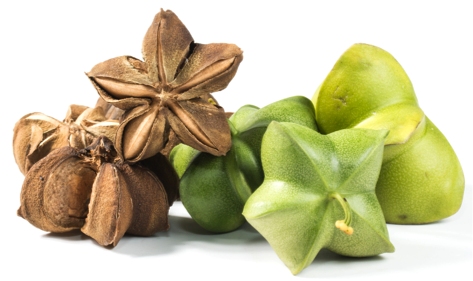
Abstract
Consumption of omega-3 fatty acids (ω-3's), whether from fish oils, flax or supplements, can protect against cardiovascular disease. Finding plant-based sources of the essential ω-3's could provide a sustainable, renewable and inexpensive source of ω-3's, compared to fish oils. Our objective was to develop a rapid test to characterize and detect adulteration in sacha inchi oils, a Peruvian seed containing higher levels of ω-3's in comparison to other oleaginous seeds. A temperature-controlled ZnSe ATR mid-infrared benchtop and diamond ATR mid-infrared portable handheld spectrometers were used to characterize sacha inchi oil and evaluate its oxidative stability compared to commercial oils. A soft independent model of class analogy (SIMCA) and partial least squares regression (PLSR) analyzed the spectral data. Fatty acid profiles showed that sacha inchi oil (44% linolenic acid) had levels of PUFA similar to those of flax oils. PLSR showed good correlation coefficients (R(2)>0.9) between reference tests and spectra from infrared devices, allowing for rapid determination of fatty acid composition and prediction of oxidative stability. Oils formed distinct clusters, allowing the evaluation of commercial sacha inchi oils from Peruvian markets and showed some prevalence of adulteration. Determining oil adulteration and quality parameters, by using the ATR-MIR portable handheld spectrometer, allowed for portability and ease-of-use, making it a great alternative to traditional testing methods.
Transcriptome analysis of Sacha Inchi (Plukenetia volubilis L.) seeds at two developmental stages.
BMC Genomics. 2012 Dec 20;13:716. doi: 10.1186/1471-2164-13-716.
Abstract
BACKGROUND:
Sacha Inchi (Plukenetia volubilis L., Euphorbiaceae) is a potential oilseed crop because the seeds of this plant are rich in unsaturated fatty acids (FAs). In particular, the fatty acid composition of its seed oil differs markedly in containing large quantities of α-linolenic acid (18C:3, a kind of ω-3 FAs). However, little is known about the molecular mechanisms
responsible for biosynthesis of unsaturated fatty acids in the developing seeds of this species. Transcriptome data are needed to better understand these mechanisms.
RESULTS:
In this study, de novo transcriptome assembly and gene expression analysis were performed using Illumina sequencing technology. A total of 52.6 million 90-bp paired-end reads were generated from two libraries constructed at the initial stage and fast oil accumulation stage of seed development. These reads were assembled into 70,392 unigenes; 22,179 unigenes showed a 2-fold or greater expression difference between the two libraries. Using this data we identified unigenes that may be involved in de novo FA and triacylglycerol biosynthesis. In particular, a number of unigenes encoding desaturase for formation of unsaturated fatty acids with high expression levels in the fast oil accumulation stage compared with the initial stage of seed development were identified.

CONCLUSIONS:
This study provides the first comprehensive dataset characterizing Sacha Inchi gene expression at the transcriptional level. These data provide the foundation for further studies on molecular mechanisms underlying oil accumulation and PUFA biosynthesis in Sacha Inchi seeds. Our analyses facilitate understanding of the molecular mechanisms responsible for the high-unsaturated fatty acids (especially α-linolenic acid) accumulation in Sacha Inchi seeds.

